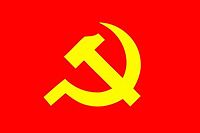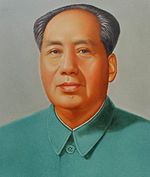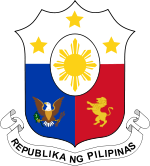- Communist Party of the Philippines
-
This article is about the party re-founded by José María Sison. For the original Communist Party of the Philippines founded in 1930, see PKP-1930.
Communist Party of the Philippines-MLM
Partido Komunista ng Pilipinas
Chairman Armando Liwanag Founded December 26, 1968 Ideology Communism,
Anti-Revisionism
Marxism–Leninism,
MaoismPolitical position Far-left Politics of the Philippines
Political parties
ElectionsThe Communist Party of the Philippines (in Filipino: Partido Komunista ng Pilipinas) is a leading communist party in the Philippines. It remains an underground political organization since its founding on December 26, 1968 and has been operating in clandestine manner since its founding. It aims to overthrow the Philippine government through armed revolution with its direct leadership over New People's Army and National Democratic Front (Philippines).
Contents
History
The Communist Party of the Philippines (CPP) was reestablished on December 26, 1968 as it splits from the Partido Komunista ng Pilipinas and coincides with the 75th birthday of Mao Zedong, the Chinese communist leader.
Amado Guerrero (allegedly the nom de guerre of Jose Maria Sison), a central committee member of Partido Komunista ng Pilipinas lead the reestablishment of the party. Jose Maria Sison, confirmed its birth at Barangay Dulacac in the tri-boundary of Alaminos, Bani and Mabini in the province of Pangasinan. This is where the CPP "congress of reestablishment" was held on December 26, 1968, at a hut near the house of the Navarettes, the parents-in-law of Arthur Garcia, one of the CPP founders.[1] Sison announced that communist guerillas held "cultural activities" and celebrated the 39th anniversary of the movement.[2] On December 26, 2007, the Communist Party of the Philippines commemorated its 39th anniversary.
According to Party documents, in 1960s onwards, a massive leftist unrest called First Quarter Storm occurred in the country to protest against the government policies, graft and corruption and decline of the economy during the presidency of Ferdinand Marcos. The unrest was also inspired by the Great Proletarian Cultural Revolution, Vietnam War and other revolutionary struggles abroad against United States imperialist aggression.
One of the leaders of the movement is Jose Ma. Sison, a founder of Kabataang Makabayan who was then recruited to be a member of Partido Komunista ng Pilipinas(PKP). During that time the new PKP members independently from PKP were conducting clandestine theoretical and political education on Marxist–Leninist vantage among workers, peasants and youth.
They advocated to resume the unfinished armed revolution against foreign and feudal domination, combat subjectivism and opportunism in the history of the old merger party and fight modern revisionism then being promoted by Soviet Union.[3]
Reestablishment Congress
Irreconcilable differences occurred between the new party members with the leadership of the PKP under Jose Lava. Sison, was tasked by PKP to conduct a review of the party history of the old merger party.
However, on his report, leaders of the PKP headed by Jesus Lava disagreed with Sison's findings that criticize the major errors of the PKP which has caused the almost total destruction of the revolutionary movement in the 1950s. A sharp division and struggle developed between them in ideological and political issues, Sison and his group lead the reestablishment of the party after he and his colleagues bolted out from the PKP. Jesus Lava, the General Secretary of the PKP was repudiated as counterrevolutionary revisionist and also the gangster clique of Pedro Taruc-Sumulong in the old people's army of the Hukbong Mapagpalaya ng Bayan (HMB), remnant of the Hukbalahap in Central Luzon.
The Party issued the document of rectification, "Rectify Errors and Rebuild the Party," and promulgated the Programme for a People's Democratic Revolution and the new Party Constitution in its Congress of Reestablishment. The two communist parties deviation was clear ideologically when the Lava's PKP was supporting the Communist Party of the Soviet Union whom Sison's group considered revisionist while the latter supported the line of the Chinese Communist Party.[4]
The reestablishment was centered on a comprehensive and thoroughgoing criticism and repudiation of modern revisionism and the Lava revisionist renegades in Manila as well as the Taruc-Sumulong gangster clique which had usurped authority over remnants of the HMB.[5]
The party congress was attended by 12 members namely Jose Maria Sison, Monico Atienza, Rey Casipe, Leoncio Co, Manuel Collantes, Arthur Garcia, Herminihildo Garcia, Ruben Guevara, Art Pangilinan, Nilo Tayag, Fernando Tayag at Ibarra Tubianosa. Jose Luneta was counted as the 13th member but he was still in China when he was elected in the Central Committee in absentia.
People's War
Part of the Politics series on Maoism  Prominent MaoistsRelated topics
Prominent MaoistsRelated topics Communism Portal
Communism Portal
Politics portalSoon after its reestablishment, the Party linked up with the other cadres and commanders of the HMB and engaged them in ideological and political studies, mass work and politico-military training. On March 29, 1969, the New People's Army was established and on April 24, 1973 the National Democratic Front (Philippines).
Afterwards, the CPP launch the "protracted people's war" a strategical line developed by Mao Zedong during the phase of guerrilla warfare of the Communist Party of China. The eventual objective is to install a "people’s revolutionary government" via a two-stages revolution: National Democratic Revolution followed by a Socialist Revolution.[6]
The reestablishment was considered by the party as the First Great Rectification Movement, criticizing the errors of the old Party. The CPP adheres to Marxism-Leninism-Maoism as its guiding ideology in analyzing and summing up the experience of the party and its creative application to the concrete conditions in the Philippines in fighting US imperialism, feudalism and bureaucrat capitalism. It considers Maoism as the highest development of Marxism-Leninism.[7]
It considers the Philippine society as semicolonial and semifeudal, the character of the present revolution as national democratic of the new type (led by the proletariat), the motive forces, the targets, the strategy and tactics and the socialist perspective of the Philippine revolution.[8]
Despite the arrests of CPP Central Committee members in 1973, 1974, 1976 and 1977, the erstwhile skeletal regional Party organizations gained flesh and muscle from the growth of the armed revolutionary movement and the urban underground.[9]
Second Great Rectification Movement
In the 10th plenum of the CPP, the Party engaged in a "second rectification movement" that reviewed and correct the erroneous errors that created a havoc on the revolutionary movement for more than a decade since its founding in 1968.
Armando Liwanag, chairman of CPP issued a document Reaffirm Our Basic Principles and Carry the Revolution Forward that repudiated the deviations of leading party cadres in the country that resulted to the gravest setbacks and destruction to the Party and the revolutionary movement, first in one major island and subsequently on a nationwide scale.
This erroneous policies has caused setbacks through a process of self-constriction and has inflicted unprecedentedly heavy losses in the strength of the Party and the people's army and gross reductions of mass base.[10]
With the criticism and debates that ensued between the leading party cadres resulted to the expulsion of advocates of "left and right opportunism" notably forming the so-called "rejectionists" and "reaffirmist" factions.
The rejectionist banners the line of "strategic counteroffensive", "regularization", and combining military adventurism with insurrectionism from 1980 onward that overlapped with reafirmist that upholds the correct revolutionary of the people's war.
The rectification movement was aimed to defeat the wrong line in a comprehensive and thoroughgoing manner and strengthen the Party ideologically, politically and organizationally. Thus, the rectification movement came into force in 1992, especially after the Plenum of the Central Committee approved the rectification documents.
Splits and Divisions
Not all CPP cadres abided the "Reaffirm" document penned by Liwanag. Those who affirmed the Maoist ortohdoxy was called the "Reaffirmists", or RA, while those who rejected the document were called "Rejectionists" or RJ. In July 1993, the Komiteng Rehiyon ng Manila-Rizal (KRMR), one of the Rejectionists, declared its autonomy from the central leadership:
“ From this day on, we severe our ties with the illegal and absolutist circle that passes itself off as the 'Central Committee' of the CPP...It is a principled declaration of independence...not a secession from the entire Party organization. ” —CPP Manila-Rizal
Within a few months, several of the Party's regional formations and bureaus followed suit: Central Mindanao, Western Mindanao, Negros and Central Visayas, the Visayas Commission (VisCom) staff and New People's Army units under its control, the National Peasant Secretariat, the United Front Commission and the Home Bureau and Western Europe committee.
The KRMR, VisCom and the Central and Western Mindanao regional committees will later merge to form the Rebolusyonaryong Partido ng Manggagawa - Pilipinas (RPM-P) in 1998. However the Mindanao-based cadres will later leave the RPM-P after a debate regarding the RPM-P's signing of a peace pact with the government then led by Joseph Estrada, they formed the Rebolusyonaryong Partido ng Manggagawa - Mindanao (RPM-M).
The KRMR faction led by Filemon Lagman was earlier expelled from the RPM-P due to his "liquidationist" attitude and refusal to help in Party preparations and functions. He will then form the Partido ng Manggagawang Pilipino (PMP), however his closest associates, led by Sonny Melencio, bolted to form the legal political party Sosyalistang Partido ng Paggawa (SPP) in 1998.
The United Front Commission cadres formed the Partido Proletaryo Demokratiko (PPD) which will then merge with Lagman's PMP and Melencio's SPP to give rise to the Partido ng Manggagawang Pilipino-Pinagsanib (PMP-Pinagsanib). But in 2007 another reported split occurrTed due to the rift between Lagman and Melencio supporters.
In 1997 several cadres from the Central Luzon committee was accused of sowing factionalism and "civilianization" of the NPA units. These cadres earlier supported the "Reaffirm" document by CPP Chairman Armando Liwanag and would attempt to appeal for the Chairman's support. The expected support did not materialize though, and the cadres formed the Marxist-Leninist Party of the Philippines (MLPP) and organized the armed wing Rebolusyonaryong Hukbo ng Bayan (RHB). The MLPP-RHB maintains the national-democratic framework of social analysis by the CPP, although slightly modified. They also maintain the People's War strategy but much more similar to Vietnamese and Nepalese revolutionary strategies.
International Relations
It participates in the Maoist International Conference of Marxist-Leninist Parties and Organizations. It heads the broad revolutionary front organization, the National Democratic Front.
Ideology
The Communist Party of the Philippines, Marxist-Leninist-Maoism (MLM), is a revolutionary proletarian party that looks upon the legacies of past Philippine rebellions and revolutions and of the theories of Karl Marx, Friedrich Engels, Vladimir Lenin, Joseph Stalin, and Mao Zedong. It assists the progress of theory and practice in the world proletarian revolution that is guided by Marxism-Leninism-Maoism (Preamble, Constitution of the Communist Party of the Philippines, 1968).[11]
“ So long as it resolutely, militantly and thoroughly carries out its ideological, political and organizational building, the Communist Party of the Philippines is certain to lead the broad masses of the Filipino people of various nationalities and ethno-linguistic communities to total victory in the national democratic revolution against US imperialism and the local reactionaries; and bring about the start of the socialist revolution. ” —Armando Liwanag, Chairman, Central Committee of the Communist Party of the Philippines
Amnesty Proclamation
Philippines 
This article is part of the series:
Politics and government of
the PhilippinesLegislature- Congress (15th Congress)
- Senate
- House of Representatives
- Speaker
- Legislative districts
- Sectoral representation
ExecutiveJudiciaryRelated topics
Other countries · Atlas
Philippine Government Portal
On September 5, 2007, President Gloria Macapagal-Arroyo signed Amnesty Proclamation 1377 for members of the Communist Party of the Philippines and its armed wing, the New People's Army; other communist rebel groups; and their umbrella organization, the National Democratic Front. The amnesty will cover the crime of rebellion and all other crimes "in pursuit of political beliefs," but not including crimes against chastity, rape, torture, kidnapping for ransom, use and trafficking of illegal drugs and other crimes for personal ends and violations of international law or convention and protocols "even if alleged to have been committed in pursuit of political beliefs." The National Committee on Social Integration (NCSI) will issue a Certificate of Amnesty to qualified applicants. Implementing rules and regulations are being drafted and the decree will be submitted to the Senate of the Philippines and the House of Representatives of the Philippines for their concurrence. The proclamation becomes effective only after Congress has concurred.[12]
On January, 2008, Avelino Razon, Philippine National Police chief stated that the New People's Army (NPA) rebels have only 5,700 members as of 2007 due to military destruction of 13 guerrilla bases (lowest level in 20 years). NPAs fought in 69 of 81 Philippine provinces since 1969. 40,000 people have died in the conflict.[13]
Ten Years for Victory
The CPP leadership, in its 41st anniversary statement, boldly calls for an advance in the revolutionary struggle and calls on its forces to make a great advance in the people’s war for new democracy. It declares its determination to strive within the next five years to make the great advance from the stage of strategic defensive to the strategic stalemate, fulfilling all the requirements and without skipping any necessary phase.
It also predicts that a revolutionary government will win the revolution by toppling the current Philippine government and establish a new state led by the Maoist in ten years.[14]
“ The strategic stalemate means that the revolutionary armed forces shall have achieved parity in the revolutionary war against the armed forces of the reactionary government. The strategic stalemate paves the way for the next stage in the protracted people’s war, namely the strategic offensive, which pushes towards the nationwide victory in the struggle for national and social liberation. ” —Armando Liwanag, Chairman, Central Committee of the Communist Party of the Philippines
As a Maoist military doctrine, the CPP-lead NPA follows the three progressive phases of protracted warfare—strategic defensive, strategic stalemate, and strategic offensive (see Mobile warfare).
The CPP considers the present revolution to be at an advance sub-stage of strategic defensive.
Revolutionary Publications
Ang Bayan (The Nation) is the national publication of the Central Committee of the Communist Party of the Philippines while the Rebolusyon (Revolution) is its theoretical journal.
Balita ng Malayang Pilipinas (Free Philippines News Service) is the news agency of the Communist Party and the National Democratic Front
Other regional and revolutionary publications include:[15]
- Liberation - Official publication of the National Democratic Front of the Philippines
- Ang Kalihukan. (Ang Kilusan/The Movement) Publication of the National Democratic Front in Northern Mindanao
- Baringkuas (Pag-aalsa/Uprising) - revolutionary newspaper of the people of Cagayan Valley
- Kahilwayan (Kalayaan/Liberation) Official newspaper of the Kabataang Makabayan-Iloilo
- Kalatas (Message) Official newspaper of the revolutionary people of Southern Tagalog
- Kalayaan (Freedom) Official newspaper of the Kabataang Makabayan
- Daba-daba (Lagablab/Flame) - Revolutionary mass paper in Panay
- Dangadang (Pakikibaka/Struggle) Revolutionary newspaper of the people of North-west Luzon
- Himagsik (Revolt) Revolutionary newspaper of the people of Central Luzon
- Larab (Lagablab/Flame) Revolutionary masspaper in Eastern Visayas
- Lingkawas (Paglaya/Liberation) Published by the Communist Party of the Philippines in Northeastern Mindanao
- Liyab (Flame) Official Publication of KAGUMA
- Malayang Pilipina (Liberated Filipina) Official Publication of MAKIBAKA
- Paghimakas (Pakikibaka/Struggle) Newspaper of the Communist Party of the Philippines in the island of Negros
- Pakigbisog (Pakikibaka/Struggle) Publication of the revolutionary people of Central Visayas
- Pasa Bilis (Courier) Published by the National Democratic Front - Southern Mindanao
- Pilipinas (Philippines) Revolutionary newspaper from the Christians for National Liberation (NDF member representing priests and religious personnel)
- Silyab (Diklap/Spark) Published by the Communist Party of the Philippines-New Peoples Army in Bicol
- Asdang (Isulong/Advance) Published by the National Democratic Front - Far South Mindanao
References
- ^ Inquirer.net, Joma Sison recalls birth of CPP in Alaminos
- ^ Abs-Cbn Interactive, Sison: 'Cultural activities' to mark CPP 39th anniversary
- ^ http://www.philippinerevolution.net/cgi-bin/statements/statements.pl?author=al;date=931226;language=eng
- ^ http://www.philippinerevolution.net/cgi-bin/cpp/pdocs.pl?id=recte;page=01
- ^ http://www.philippinerevolution.net/cgi-bin/statements/statements.pl?author=al;date=881226;language=eng
- ^ http://www.philippinerevolution.net/cgi-bin/cpp/pdocs.pl?id=pdr_e;page=03#1
- ^ http://www.philippinerevolution.net/cgi-bin/cpp/pdocs.pl?id=recte;page=01
- ^ http://pcij.org/stories/a-stronger-revolutionary-movement/
- ^ http://www.philippinerevolution.net/cgi-bin/statements/statements.pl?author=al;date=881226;language=eng
- ^ http://www.philippinerevolution.net/cgi-bin/cpp/pdocs.pl?id=reafe;page=01
- ^ [PRWC Party Documents] Saligang Batas ng Partido Komunista ng Pilipinas, December 26, 1968
- ^ Inquirer.net, Arroyo signs amnesty proclamation for communists
- ^ ABS-CBN Interactive, NPAs down to 5,700
- ^ http://www.ndfp.net/liberation_intl/zzLI_103103/LI_31mar2010b.pdf
- ^ http://www.philippinerevolution.net/pub/mindex.shtml
External links
Political parties in the Philippines 
Senate (24): Liberal (4) · Nacionalista (4) · Lakas-Kampi (3) · NPC (2) · PDP-Laban (2) · PMP (2) · LDP (1) · PRP (1) · Independent (4)House of
Representatives (286):Districts (229):Liberal (73) · Lakas-Kampi (61) · NUP (30) · NPC (30) · Nacionalista (22) • PMP (5) · PDP-Laban (2) · Biled (1) · LDP (1) · KBL (1) · Independent (2)Party-lists (55):Ako Bicol (3) · Senior Citizens (2) · Akbayan (2) · GABRIELA (2) · Coop-NATCCO (2) · 1-CARE (2) · Abono (2) · Bayan Muna (2) · An Waray (2) · CIBAC (2) · A TEACHER (1) · AGAP (1) · Butil (1) · Anakpawis (1) · Kabataan (1) · LPG Marketers Association (1) · Abante Mindanao (1) · Alliance of Concerned Teachers (1) · AAMBIS-OWA (1) · YACAP (1) · APEC (1) · ANAD (1) · Ang Kasangga (1) · Bagong Henerasyon (1) · Ang Galing Pinoy (1) · Agbiag (1) · PBA (1) · ABS (1) · TUCP (1) · AGHAM (1) · DIWA (1) · KAKUSA (1) · KALINGA (1) · ALIF (1) · Alagad (1) · Una ang Pamilya (1) · AVE (1) · Aangat Tayo (1) · ATING KOOP (1) · AA-Kasosyo (1) · ALE (1)
Presidential election: Gubernatorial elections: Aksyon Demokratiko · Bigkis Pinoy · PGRPPortal:Politics · List of political parties · Politics of the Philippines Categories:- Communist parties in the Philippines
- Political parties in the Philippines
- International Conference of Marxist–Leninist Parties and Organizations (International Newsletter)
- Maoist organizations
- Political parties established in 1968
- Clandestine groups
Wikimedia Foundation. 2010.

